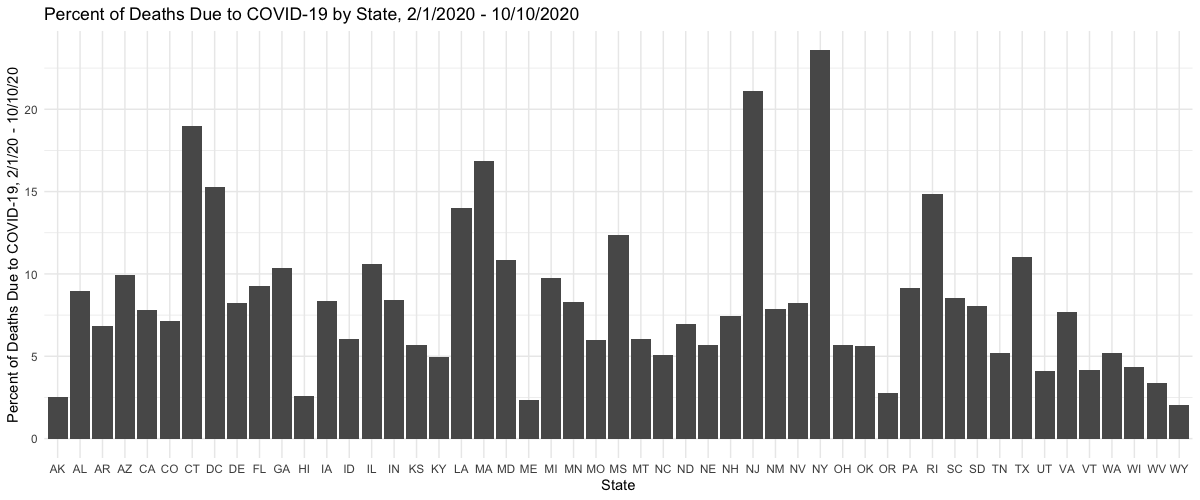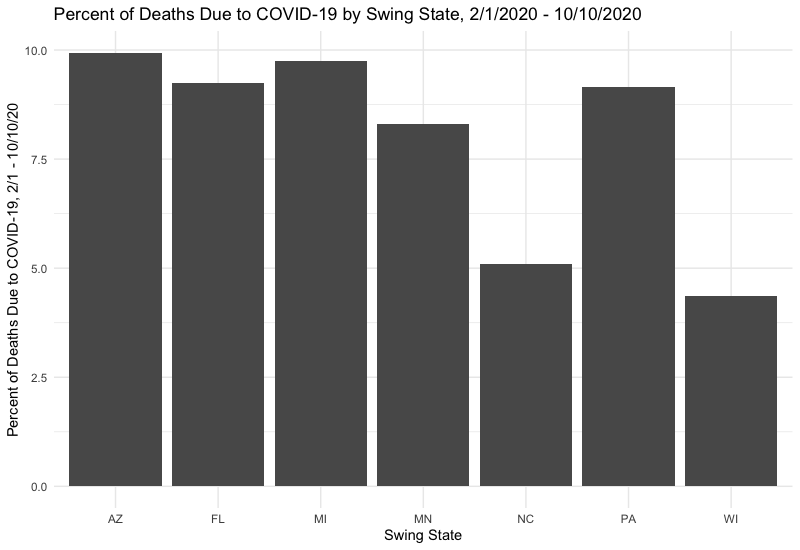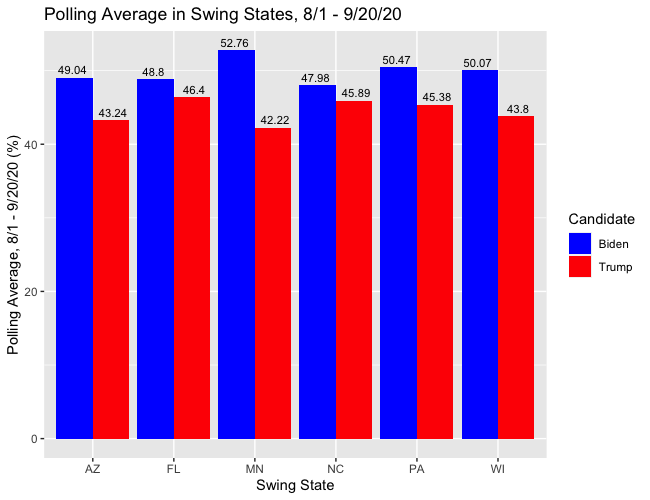electionblog
Blog Post 10/24/2020: How will COVID-19 Affect the 2020 Election?The COVID-19 pandemic has been world-changing and has become likely the most salient issue on the populace’s mind. It has affected the economy, public health, and has reinvented a new normal in the United States. As this issue will be on many voters’ minds on election day in less than two weeks, I found it appropriate to investigate in this week’s blog. In Part 1, I will analyze how the novel coronavirus affected all 50 states in terms of the percent of all deaths due to COVID-19, and then will focus more specifically on swing states. In Part 2, I investigate the polling averages in these swing states and look into how the coronavirus may have affected them.
Part 1: How have different states experienced the pandemic?In Part 1, I analyzed how the coronavirus has affected the 50 states. I used a dataset on COVID-19 data from 2/1/2020 - 10/10/2020 by county from the CDC, grouped and summarized it by state, and created a new variable: percentage of all deaths due to COVID-19. Figure 1, below, demonstrates a visualization of each state’s percentage of all deaths due to the coronavirus. I used this variable because it may be a good indicator of the severity of the outbreaks in a state. The top four states by a percentage of deaths during this time period were New York (23.58%), New Jersey (21.14%), Connecticut (18.98%), and Massachusetts (16.87%). This is because these Northeastern states were among the first to have outbreaks in the United States. New York City alone had 35% of all COVID-19 cases in the United States on March 23rd [1]. As the virus spread to the rest of the country, states took various measures to contain the virus, including mask mandates, promoting social distancing, business restrictions, and others. While this chart provides insights into the severity of the outbreaks in different states, it does not tell us much about how the pandemic affects the 2020 presidential election.
Thus, I created a chart with the same data but only included the 7 states that have at least a 5% chance of being the tipping point state on the FiveThirtyEight forecast: Pennsylvania (28.4%), Wisconsin (13.1%), Florida (12.6%), Michigan (10.0%), North Carolina (6.2%), Arizona (5.5%), and Minnesota (5.5%) [2].

It is clear that Arizona, Florida, Michigan, Minnesota, and Pennsylvania are similar in terms of percent of deaths due to COVID-19, with their percentages all in the 8.2 - 10.0% range. The outliers are North Carolina with 5.10% and Wisconsin with 4.37%. This difference caused me to question whether the lower percentage of deaths due to the coronavirus in North Carolina and Wisconsin would be reflected in the polling data. The pandemic is a top issue in this fall’s election and may be a major factor in people’s decisions on who to vote for. Pew Research released a poll in early October that shows former Vice President Joe Biden with a 17% advantage, 57%-40%, over President Trump in registered voters’ confidence in his ability to “handle the public health impact of the coronavirus” [3]. Thus, in part 2, I analyze the polling in these swing states and look into whether Biden is polling worse in states where the coronavirus has caused a lower share of deaths.

In Part 2, I used a dataset with 2020 election polls by state. I filtered the dataset to only include polls that started on or after August 1,2020 to have a sample in which each state had experienced a COVID-19 summer. I also only included polls that are rated at least an A- on FiveThirtyEight, as state polling can be more varied and inaccurate. I then graphed the polling averages in these states, below.

Biden has a clear lead in most of these swing states, but his leads in Florida and North Carolina are both within a 2.5% margin of error. The theory in Part 1, that the lower percentage of all deaths due to COVID-19 in North Carolina and Wisconsin would hurt Biden or help Trump, does not have enough evidence to be proven. On the one hand, Biden’s lead in North Carolina is 2.09%, the smallest difference among these states, but on the other, Biden has a 6.27% lead in Wisconsin, one of his larger leads. Further research would be required to make such a hypothesis statistically significant.
Conclusions and SourcesA key takeaway from this week’s post is that the coronavirus pandemic is dangerous and will influence people’s votes. It is interesting to note that Biden has a polling lead in all of these likely tipping point states, despite President Trump winning all of them but Minnesota in 2016. This bodes well for the former VP’s chances and it is likely that the President’s management of the pandemic hurts his own chances.
This week’s prediction: Biden win.
Thank you for reading! You can follow my election modeling journey by checking this blog each Saturday through December.
To complete this blog post, I utilized a coronavirus dataset from the CDC and a 2020 polls dataset from the Gov 1347: Election Analytics course website.
[1] https://abcnews.go.com/US/News/timeline-100-days-york-gov-andrew-cuomos-covid/story?id=71292880
[2] https://projects.fivethirtyeight.com/2020-election-forecast/
[3] https://www.pewresearch.org/politics/2020/10/09/amid-campaign-turmoil-biden-holds-wide-leads-on-coronavirus-unifying-the-country/